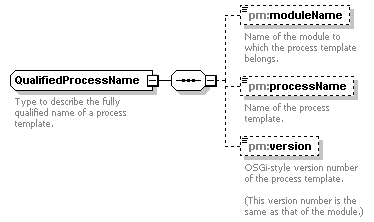| diagram |  |
||
| namespace | http://www.tibco.com/bx/2009/management/processManagerType | ||
| children | pm:moduleName pm:processName pm:version | ||
| used by |
|
||
| annotation |
|
||
| source | <xsd:complexType name="QualifiedProcessName"> <xsd:annotation> <xsd:documentation>Type to describe the fully qualified name of a process template.</xsd:documentation> </xsd:annotation> <xsd:sequence> <xsd:element name="moduleName" type="xsd:string" nillable="true" minOccurs="0"> <xsd:annotation> <xsd:documentation>Name of the module to which the process template belongs.</xsd:documentation> </xsd:annotation> </xsd:element> <xsd:element name="processName" type="xsd:string" nillable="true" minOccurs="0"> <xsd:annotation> <xsd:documentation>Name of the process template.</xsd:documentation> </xsd:annotation> </xsd:element> <xsd:element name="version" type="xsd:string" nillable="true" minOccurs="0"> <xsd:annotation> <xsd:documentation>OSGi-style version number of the process template. (This version number is the same as that of the module.)</xsd:documentation> </xsd:annotation> </xsd:element> </xsd:sequence> </xsd:complexType> |
WSDL documentation generated by XMLSpy WSDL Editor http://www.altova.com/xmlspy